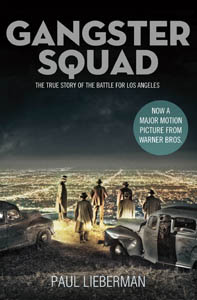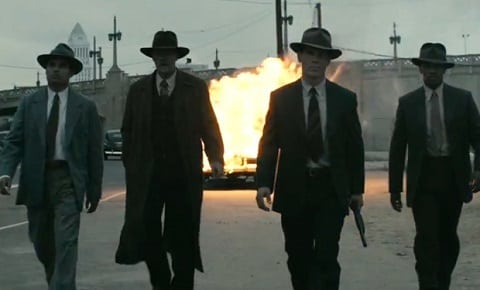
‘GANGSTER SQUAD: Covert Cops, the Mob, and the Battle for Los Angeles’ is written by Paul Lieberman (Pan Macmillan) and out now in non-fiction paperback.
Based on his hugely popular Los Angeles Times column ‘LA NOIR: TALES FROM THE GANGSTER SQUAD’, this is the true story of a brutal secret police team operating in 1950s Los Angeles. It has inspired the major new Warner Brothers film of the same name, starring Ryan Gosling and Emma Stone. The film is released on January 11th 2013.
Based on hundreds of interviews with everyone from anonymous LAPD foot soldiers to the families and associates of those they pursued, Lieberman stitches together the story of Jack O’Mara, his dangerous colleague Jerry Wooters and their anything-goes war with arch-criminal Mickey Cohen and his budding rival Jack ‘The Enforcer’ Whalen.
Stake-outs, shoot-outs and even the famous Black Dahlia murder case, this is ice-cool narrative non-fiction at its best – and the basis for a huge and much anticipated Warner Brothers film of the same name.
Author Paul Lieberman discusses more about the book and the upcoming film adaptation in the Q+A session below…
Q: Anyone who sees the trailer for Warner Bros.’ movie version of “Gangster Squad” might think this is a classic cops-v.-robbers tale with lots of shootouts. But the book is much more, isn’t it?
Yes, absolutely. On the surface, sure, it is the tale of two Los Angeles police veterans who become obsessed with the showboating mobster Mickey Cohen as he causes havoc in the city in the years after World War II. Then another rising gangster tries to move in on the rackets, Jack “the Enforcer” Whalen, a powerful Irishman who prided himself on being so tough he didn’t need a gun…
…and dreamed of making it in Hollywood, as an actor, right?
Correct—the feared “Enforcer” yearned to be a cowboy in Westerns. He might have realized his dream had he not stormed into the restaurant that served as Mickey’s hangout in the closing days of the ‘50s. That’s when a bullet between the eyes upended the lives of all the main characters and, I argue, ended an era in Los Angeles. That’s the basic story. But the bigger picture involves the worldview that dominated L.A. as it grew into a giant, modern city that supposedly embodied the American Dream.
That broad theme centers on the city’s own self-image, right?
For decades, city fathers had a paranoid obsession with gangsters invading from elsewhere to despoil their sun-washed paradise. L.A. was the city of eternal sunshine and self-invention, the City of Angels. Gangsters belonged in the cesspool cities back east. You heard this notion in L.A. going back to the 1800s and it was the impetus for forming the Gangster Squad in 1946. One crime report actually had a section titled “The Invasion of Undesirables.” In sum: evil came from without, not within.
And that same delusion applies to your main characters, the cops, as individuals.
Yes. This was the period when a popular TV show “Dragnet” was glorifying the LAPD – the hero, Sgt. Joe Friday, lived with his mother! But the real cops were complicated men, not so pure. The main one, Sgt. Jack O’Mara, was his church’s head usher on Sundays but other days was not so godly while he tried to combat hoods such as Cohen and Jack Dragna, the Sicilian who headed the local branch of the Mafia…
O’Mara took such characters up into the hills, putting guns in their ears…
…and squad members were always breaking into their homes to plant listening devices, all without warrants. They even helped Jack Webb, the producer and star of “Dragnet,” bug his estranged wife.
One bug was planted right inside Mickey’s TV – it was amazing how O’Mara pulled that off…
The same with how others bugged the bed of Dragna’s mistress. They couldn’t get the Mafia boss for ordering murders so they got him for deviant sex acts, actually stuff regularly depicted in movies today.
Is it true that Los Angeles was never able to get a conviction in a mob hit for more than half a century?
People raised in the post-“Godfather” era have no idea how little America knew about the mob then. The country’s top lawman, J. Edgar Hoover, head of the FBI, for ages refused to acknowledge there was a national crime network. He set his agents after bank-robbing desperados like Pretty Boy Floyd and John Dillinger, but not the Mafia. That spurred great tension between Hoover and Los Angeles police – the LAPD formed its Gangster Squad a full decade before he was forced to acknowledge the threat of organized crime after hoods from around the country were discovered meeting on a ranch in upstate New York. What’s more, the Mafia still was ruled by an unwavering code of silence, omerta. The first insider to spill its secrets, Joe Valachi, did not surface until the 1960s. The code of silence was a prime reason the city was unable to get a conviction in a mob rubout. The first real one does not come until the killing that culminates “Gangster Squad,” of Jack Whalen. And then nothing is as it seems. “Noir” takes over.
How do you put it? “Truth is not found in the sunlight…”
…and justice is not obtained in a marble courthouse.
And so justice finally catches up with Mickey Cohen…
They’ll have to read the book.
That involves a fascinating figure we’ve never heard of before, Jack Whalen’s father, a pool shark and conman known as “Freddie the Thief,” a colorful character right out of the movie “The Sting.” His trek from the Midwest to Los Angeles in 1922 kicks off your story. Obviously there are all sorts of records to document the life of a Mickey Cohen but how did you learn so much about this clever conman?
I had three researchers helping over the years and we found details of Freddie Whalen’s schemes stashed in various court archives. More importantly, his daughter was still alive up in Oregon, nearing 90, and she was proud of having helped in his most clever con, in which he would go to hospitals posing as a doctor who liked to bet on horse races, the start of a scam that victimized bookies around the country.
But you caution us several times that family lore is not always reliable.
It’s not—that’s why you get thousands of pages of records. The second main cop, Sgt. Jerry Wooters, supposedly had been shot down over the Pacific during World War II and left floating in a raft. But you better believe I got his complete military file just to make sure that happened. It did.
You also seem to have been obsessed with finding witnesses to the shooting that’s the climax to the book, after Jack “the Enforcer” marches into Rondelli’s to confront Mickey and his men.
That killing was a grossly underreported moment in Los Angeles history. It barely got a mention in accounts of Mickey Cohen’s life. So I tracked down everyone I could – from the two cops sitting in a police car outside, to the striptease dancer who had a date to meet Mickey’s crew, to two of the associates at his table that night, one of whom now insists that Mickey himself…well, you’ll have to read it. But most significantly, the night is the payoff for the trap that my main cop, O’Mara, set a decade before when he secretly marked all of Mickey’s guns in case they someday showed up at a murder.
Why do you call that killing the end of as era?
For starters, Los Angeles finally gets a conviction in a mob rubout, even if it’s not all it seems. And court decisions begin to spell an end to anything-goes policing, which is why O’Mara quits the force. “It just got to be no fun anymore,” is how he put it. The inner city is about to erupt in riots – the days of White Men Rule are coming to a close. All the cultural changes of the ‘60s are around the corner too. Even the onset of color television is worth pondering – no more seeing the world in black-and-white.
Is it true that one of the old cops, the original bug man, refused to talk to you for a decade?
Yes, Con Keeler. He never said why he finally decided to talk and share his secrets. I never asked, either.
The book’s cover says the true tale “inspired” Warner Bros.’ upcoming movie of “Gangster Squad.” Is that an acknowledgement that a lot of license was taken in the film in the name of cinematic drama?
Short answer, yes. The characters are there: O’Mara is played by Josh Brolin, Wooters by Ryan Gosling and Mickey by Sean Penn. But it’s a Warner Bros. gangster film. That studio was behind the old classics of the genre staring James Cagney, Humphrey Bogart and the like. So the film also is a riff on the genre, meaning there’s a lot more violence than in real life. O’Mara did sleep with a Tommy gun under his bed but the squad didn’t have the wild shootouts you’ll see in the film. One of O’Mara’s daughters is unsettled by the violence but his other daughter attended a lot of the shoot and was fine with it. “It’s a movie,” she noted. The movie is set in 1949, the year Warner Bros. released one of its greatest gangster films, “White Heat,” in which Cagney plays a deranged hood a bit too close to his mother. The famous last scene has him high atop an oil refinery, where he shouts as it blows up, “Made it Ma! Top of the world!” That too was cinematic invention, not real life. I think audiences understand the difference.
But real-life violence did force the studio to postpone release of the film.
A major scene had the bad guys lurking behind a movie screen showing a John Wayne film, then blasting away at the Gangster Squad with their own Tommy guns. Then came the real tragedy in Colorado this past summer in which a deranged graduate student killed 12 people at a showing of the new “Batman” film. Warner Bros. wisely decided to scrap the film’s theater scene and reshoot a whole new ambush, now set in Los Angeles’ Chinatown. That meant a four month delay in the release, until January.
Any good gossip from the set?
The book’s Afterword deals with the filming, mostly the interaction between the real cops’ families and the Hollywood spectacle. But Ryan Gosling does tell a good story on Sean Penn while Sean was getting into character playing Mickey Cohen. The ingénue Emma Stone figures in the story too. Check it out.
You suggest that Mickey Cohen was a modern figure ahead of his time, a publicity hound.
Indeed. He invited “Life” magazine to his home to take pictures of his fancy suits, his wife’s mirrored boudoir and the little bed used by their dog, Tuffy. He also went on television to insult Los Angeles’ police chief and the head of the Gangster Squad, calling them crooked degenerates. Taunting the cops was very stupid, to say the least. But today he’d have his own reality TV show, guaranteed.
The film version of GANGSTER SQUAD is at cinemas from January 11th 2013 and stars Sean Penn, Ryan Gosling and Emma Stone



Be the first to comment